Lessons Learned Working on Another Part of the Greater Findhorn Dunes System
Introduction
In November 2023, staff from RSPB Scotland invited members of the Findhorn Hinterland Trust and the Findhorn Dunes Trust to the RSPB’s Culbin Sands Nature Reserve for a site visit. The aim of the visit was for the RSPB to share their experience of managing invasive dune scrub at Culbin Sands as part of the current LIFE 100% for Nature project. As the Findhorn Hinterland and Findhorn Dune Trusts are planning a dune restoration project for the Findhorn Dunes, this was a good opportunity to share appropriate knowledge gained at a neighbouring site. Culbin Sands is part of the wider dune complex that also encompasses the Findhorn Dunes, the issues and processes that affect the dunes at Culbin Sands are likely to be the same as those that affect the dunes at Findhorn.
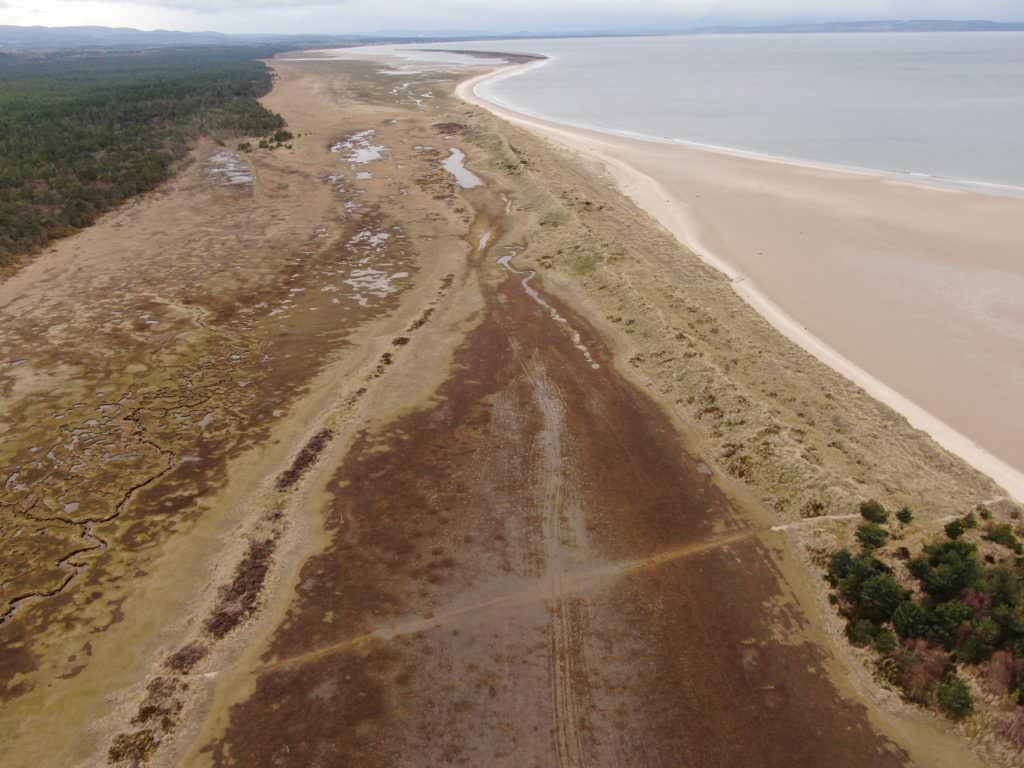
Aerial view of Culbin
Culbin Sands
Culbin Sands includes large areas of saltmarsh, sandflats and mudflats, sand dune and coastal vegetated shingle habitat. The reserve was acquired by the RSPB in 1977, with one of the main focuses of the reserve being to protect the sandflat and mudflat feeding areas of wintering waterbirds and waders such as Long-Tailed Duck, Curlew and Pink-Footed Goose. In addition to this, the reserve includes around 60 hectares of sand dune and coastal vegetated shingle habitat that is of national and regional importance. The coastal vegetated shingle bar is almost certainly the most intact example of this habitat type in Scotland and one of the most important sites of this type in the United Kingdom.
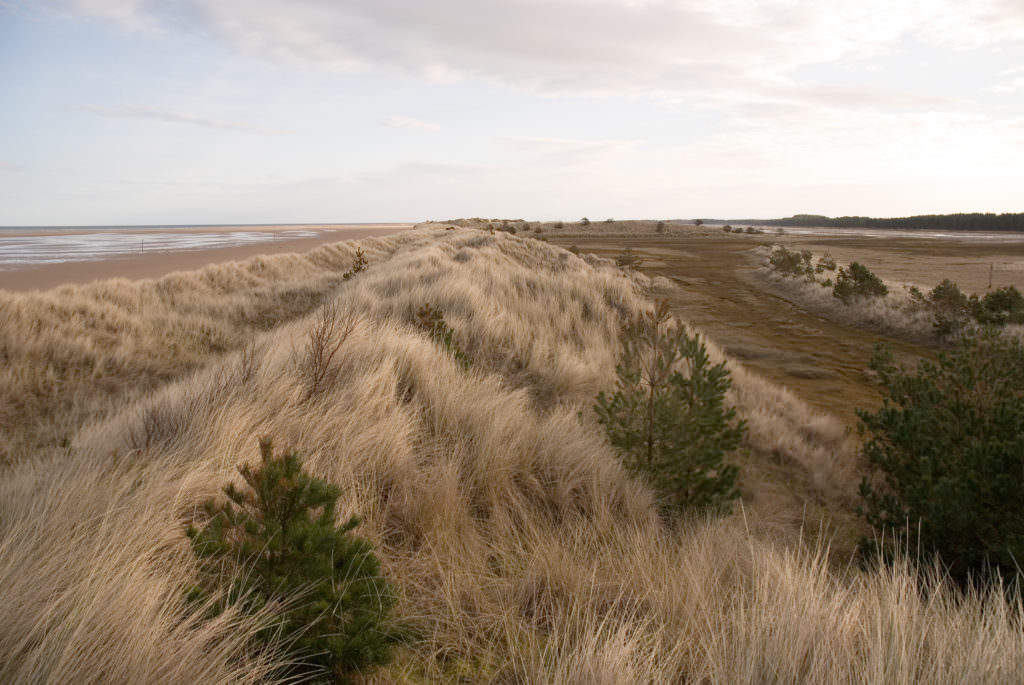
Both the shingle and dune habitats are included in the designation of the Culbin Bar SAC (Special Area of Conservation). Unfortunately, the embryonic shifting dune habitat element of the SAC was classed as unfavourable and declining due to invasive scrub by site condition monitoring in 2010. The coastal vegetated shingle habitat in the SAC was judged to be in favourable condition but it was noted that invasive scrub was having an increasing impact on the overall condition of the habitat. The cover of scrub on the dune and shingle habitat at Culbin Sands has been steadily increasing over the last 30-40 years. Historic aerial imagery shows that scrub on some of the dune has gone from sparse cover to thick, almost continuous cover within 20 years.
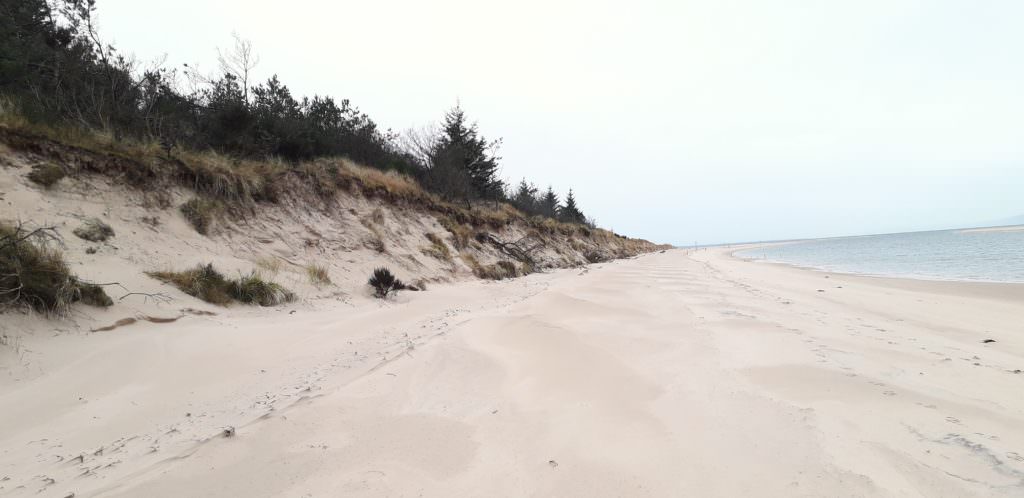
The LIFE 100% for Nature Project
In an effort to reverse these declines in habitat condition, the dune and shingle habitat at Culbin Sands was included in the LIFE 100% for Nature Project. This project is working to reverse declines in habitat condition within 11 SAC’s under RSPB management across Scotland, with other sites including Tiree, Insh Marshes and Nigg and Udale Bays. At Culbin Sands the project is aiming to remove all invasive scrub from dune habitats and to reduce the cover of scrub on the shingle habitats that are under RSPB management. The Project’s main approach to achieving these aims has been to build up a team of more than 20 local volunteers who take part in frequent work parties that are managed by the LIFE Project Officer, David Tompkins. This approach delivers high quality habitat management over several years that is sensitive and adaptable by design. The alternative would be to employ contractors with machinery to do the work at scale in a shorter time frame, this was not feasible as the saltmarsh surrounding the dune habitat at Culbin is fragile and vulnerable to damage from vehicle access.
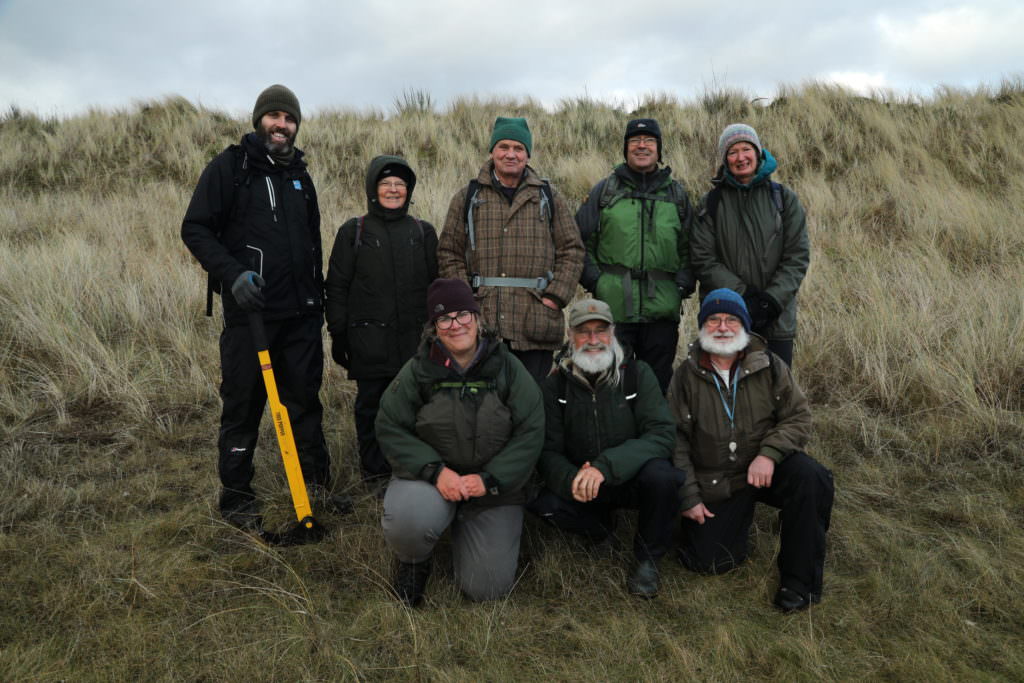
Group photo during Findhorn Hinterland Trust visit with RSPB to Culbin
Benefits
The main purpose of removing invasive scrub from the dunes at Culbin is to bring back dynamism to the dunes by allowing natural processes to act on the dune system as they have done since the dunes came into existence. Prior to the LIFE 100% for Nature Project, some areas of the dune had a continuous cover of birch and pine scrub, this restricted sand movement through the dune which appeared to limit the growth of new embryo dunes. A reduction in the formation of embryo dunes renders dune systems more vulnerable to blow out and erosion events during winter storms. Since removing almost all of the mature scrub from the dune habitat under RSPB management at Culbin, we have seen evidence of increased sand movement along the length of the dune.
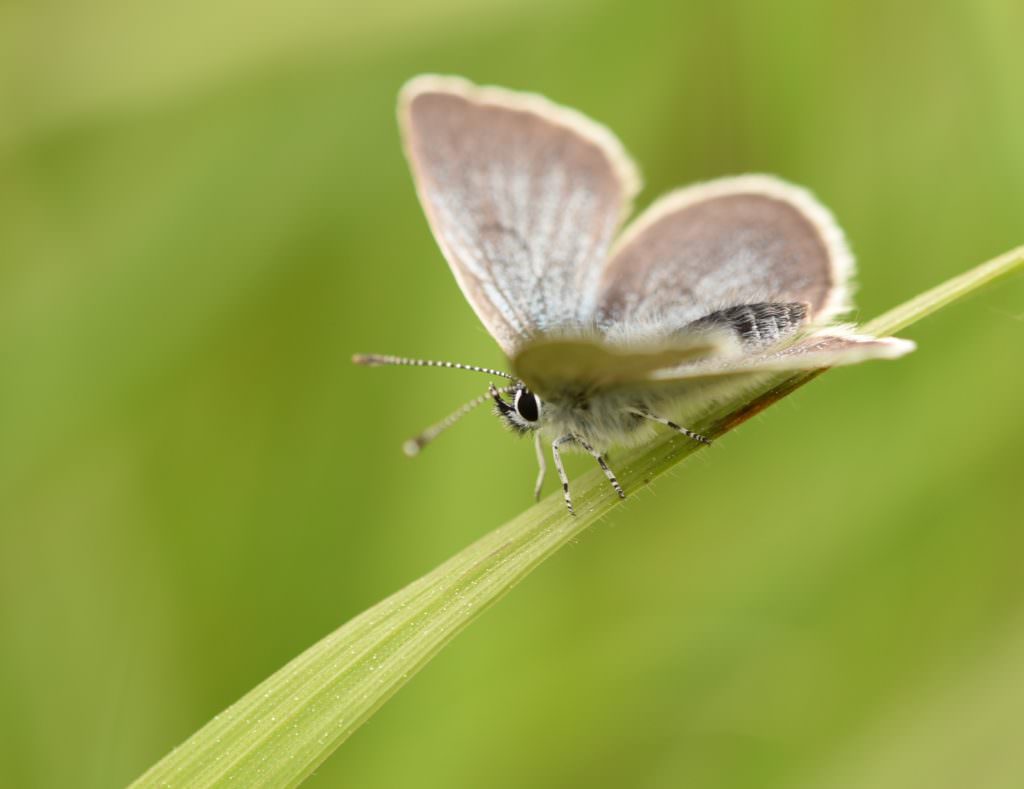
Small Blue Butterfly Cupido minimus
Allowing natural processes to take hold has appeared to benefit a range of dune species. For example, the increased sand movement keeps the dune sward open which benefits key dune species like Mouth-ear Hawkweed Pilosella officinarum and the Sand Bear Spider Arctosa perita. Reducing scrub cover has improved the outlook for an important colony of Small Blue Butterfly Cupido minimus at the western end of the shingle bar at Culbin. This work has prevented the food plant of the butterfly, Kidney vetch Anthyllis vulneraria, from being shaded out by encroaching pine scrub.

West dune tip before

West dune tip after
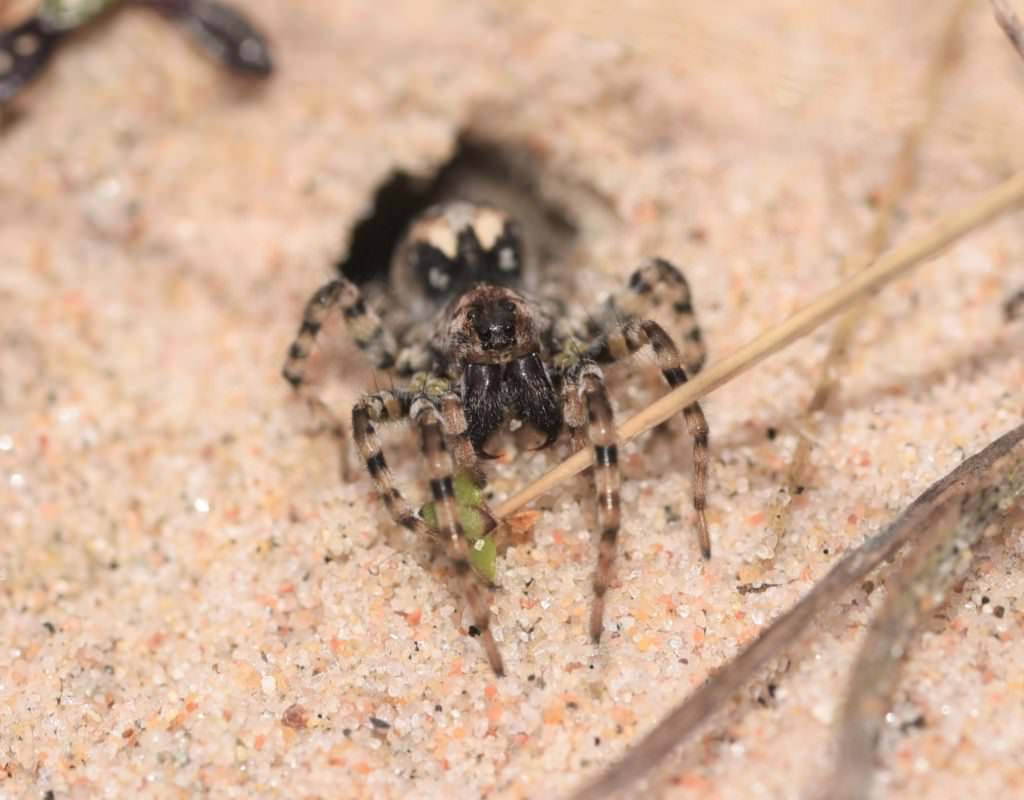
Sand bear spider Arctosa perita in burrow Culbin bar
Lessons learnt and shared
Lessons have certainly been learnt from efforts to manage dune scrub as part of the LIFE 100% for Nature Project, these lessons are likely to apply to any restoration projects on the Findhorn Dunes. One key positive lesson is that investing time and resources into a local network of volunteers gives you an adaptable and capable workforce that is well equipped to manage dune scrub. On a more practical note, several lessons have been learnt. First, it is important not to underestimate the time it takes to dispose of brash resulting from scrub clearance, scrub that may take a day to clear with a large group may then take five days to dispose of by burning. This is pertinent for all sites where access prevents the off-site removal of brash. The second, possibly even more important lesson, is that the regeneration capacity of scrub (particularly Broom and Birch) should not be underestimated.
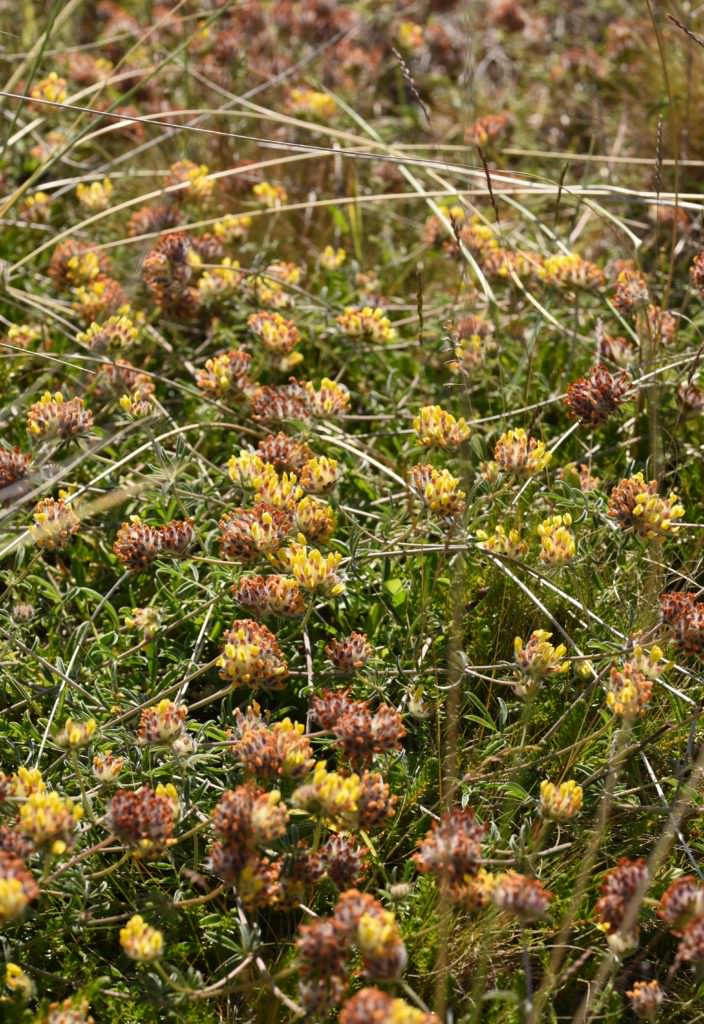
Kidney vetch shingle
Broom regeneration from seed is a particular challenge on the dune at Culbin Sands, with dense areas of Broom seedlings arising from cleared areas of mature broom scrub. These seedlings present a management problem as they are deep rooted, numerous and will readily regrow if they are cut before they reach reproductive age (typically three years old). Clearing mature Broom stands appears to create ideal conditions for seed germination, possibly due to soil disturbance and increased levels of light reaching the soil surface. Fortunately, there is a reasonable body of literature available on Broom ecology as it is a major invasive species in New Zealand, Australia and the United States, so land managers can arm themselves with information prior to managing Broom. (CABI have produced a good summary on the ecology of Broom, it can be accessed here: Cytisus scoparius (Scotch broom) | CABI Compendium (cabidigitallibrary.org)) Any dune restoration efforts that include the removal of Broom should be prepared to deal with a flush of Broom seedlings following management, especially in bare areas. It has been noted that Broom seedlings seem much less frequent amongst mature Heather Calluna vulgaris and Crowberry Empetrum nigrum vegetation at Culbin, possibly because the vegetation prevents an increase in light hitting the soil that would otherwise trigger germination.
The future
Whilst challenges remain, there are reasons to be optimistic about the future of Culbin Sands and the wider Culbin-Findhorn dune complex. There appears to be an increased awareness of the importance of sand dune habitats amongst the local community, with many people understanding that there is a need to prevent scrub from encroaching onto dune habitats. Dune habitats themselves seem to be showing resilience too. Dunes at the western end of the vegetated shingle bar are growing westward at the rate of up to 5 metres per year, having cleared young scrub from a large swathe of this dune it should in future be easier to hold the line and not allow any new scrub to develop in this area of ever-expanding dune.
David Tompkins
RSPB Life Project Officer
January 2024

















RSPB Culbin Sands Nature Reserve Project
Lessons Learned Working on Another Part of the Greater Findhorn Dunes System
Introduction
In November 2023, staff from RSPB Scotland invited members of the Findhorn Hinterland Trust and the Findhorn Dunes Trust to the RSPB’s Culbin Sands Nature Reserve for a site visit. The aim of the visit was for the RSPB to share their experience of managing invasive dune scrub at Culbin Sands as part of the current LIFE 100% for Nature project. As the Findhorn Hinterland and Findhorn Dune Trusts are planning a dune restoration project for the Findhorn Dunes, this was a good opportunity to share appropriate knowledge gained at a neighbouring site. Culbin Sands is part of the wider dune complex that also encompasses the Findhorn Dunes, the issues and processes that affect the dunes at Culbin Sands are likely to be the same as those that affect the dunes at Findhorn.
Aerial view of Culbin
Culbin Sands
Culbin Sands includes large areas of saltmarsh, sandflats and mudflats, sand dune and coastal vegetated shingle habitat. The reserve was acquired by the RSPB in 1977, with one of the main focuses of the reserve being to protect the sandflat and mudflat feeding areas of wintering waterbirds and waders such as Long-Tailed Duck, Curlew and Pink-Footed Goose. In addition to this, the reserve includes around 60 hectares of sand dune and coastal vegetated shingle habitat that is of national and regional importance. The coastal vegetated shingle bar is almost certainly the most intact example of this habitat type in Scotland and one of the most important sites of this type in the United Kingdom.
Both the shingle and dune habitats are included in the designation of the Culbin Bar SAC (Special Area of Conservation). Unfortunately, the embryonic shifting dune habitat element of the SAC was classed as unfavourable and declining due to invasive scrub by site condition monitoring in 2010. The coastal vegetated shingle habitat in the SAC was judged to be in favourable condition but it was noted that invasive scrub was having an increasing impact on the overall condition of the habitat. The cover of scrub on the dune and shingle habitat at Culbin Sands has been steadily increasing over the last 30-40 years. Historic aerial imagery shows that scrub on some of the dune has gone from sparse cover to thick, almost continuous cover within 20 years.
The LIFE 100% for Nature Project
In an effort to reverse these declines in habitat condition, the dune and shingle habitat at Culbin Sands was included in the LIFE 100% for Nature Project. This project is working to reverse declines in habitat condition within 11 SAC’s under RSPB management across Scotland, with other sites including Tiree, Insh Marshes and Nigg and Udale Bays. At Culbin Sands the project is aiming to remove all invasive scrub from dune habitats and to reduce the cover of scrub on the shingle habitats that are under RSPB management. The Project’s main approach to achieving these aims has been to build up a team of more than 20 local volunteers who take part in frequent work parties that are managed by the LIFE Project Officer, David Tompkins. This approach delivers high quality habitat management over several years that is sensitive and adaptable by design. The alternative would be to employ contractors with machinery to do the work at scale in a shorter time frame, this was not feasible as the saltmarsh surrounding the dune habitat at Culbin is fragile and vulnerable to damage from vehicle access.
Group photo during Findhorn Hinterland Trust visit with RSPB to Culbin
Benefits
The main purpose of removing invasive scrub from the dunes at Culbin is to bring back dynamism to the dunes by allowing natural processes to act on the dune system as they have done since the dunes came into existence. Prior to the LIFE 100% for Nature Project, some areas of the dune had a continuous cover of birch and pine scrub, this restricted sand movement through the dune which appeared to limit the growth of new embryo dunes. A reduction in the formation of embryo dunes renders dune systems more vulnerable to blow out and erosion events during winter storms. Since removing almost all of the mature scrub from the dune habitat under RSPB management at Culbin, we have seen evidence of increased sand movement along the length of the dune.
Small Blue Butterfly Cupido minimus
Allowing natural processes to take hold has appeared to benefit a range of dune species. For example, the increased sand movement keeps the dune sward open which benefits key dune species like Mouth-ear Hawkweed Pilosella officinarum and the Sand Bear Spider Arctosa perita. Reducing scrub cover has improved the outlook for an important colony of Small Blue Butterfly Cupido minimus at the western end of the shingle bar at Culbin. This work has prevented the food plant of the butterfly, Kidney vetch Anthyllis vulneraria, from being shaded out by encroaching pine scrub.
West dune tip before
West dune tip after
Sand bear spider Arctosa perita in burrow Culbin bar
Lessons learnt and shared
Lessons have certainly been learnt from efforts to manage dune scrub as part of the LIFE 100% for Nature Project, these lessons are likely to apply to any restoration projects on the Findhorn Dunes. One key positive lesson is that investing time and resources into a local network of volunteers gives you an adaptable and capable workforce that is well equipped to manage dune scrub. On a more practical note, several lessons have been learnt. First, it is important not to underestimate the time it takes to dispose of brash resulting from scrub clearance, scrub that may take a day to clear with a large group may then take five days to dispose of by burning. This is pertinent for all sites where access prevents the off-site removal of brash. The second, possibly even more important lesson, is that the regeneration capacity of scrub (particularly Broom and Birch) should not be underestimated.
Kidney vetch shingle
Broom regeneration from seed is a particular challenge on the dune at Culbin Sands, with dense areas of Broom seedlings arising from cleared areas of mature broom scrub. These seedlings present a management problem as they are deep rooted, numerous and will readily regrow if they are cut before they reach reproductive age (typically three years old). Clearing mature Broom stands appears to create ideal conditions for seed germination, possibly due to soil disturbance and increased levels of light reaching the soil surface. Fortunately, there is a reasonable body of literature available on Broom ecology as it is a major invasive species in New Zealand, Australia and the United States, so land managers can arm themselves with information prior to managing Broom. (CABI have produced a good summary on the ecology of Broom, it can be accessed here: Cytisus scoparius (Scotch broom) | CABI Compendium (cabidigitallibrary.org)) Any dune restoration efforts that include the removal of Broom should be prepared to deal with a flush of Broom seedlings following management, especially in bare areas. It has been noted that Broom seedlings seem much less frequent amongst mature Heather Calluna vulgaris and Crowberry Empetrum nigrum vegetation at Culbin, possibly because the vegetation prevents an increase in light hitting the soil that would otherwise trigger germination.
The future
Whilst challenges remain, there are reasons to be optimistic about the future of Culbin Sands and the wider Culbin-Findhorn dune complex. There appears to be an increased awareness of the importance of sand dune habitats amongst the local community, with many people understanding that there is a need to prevent scrub from encroaching onto dune habitats. Dune habitats themselves seem to be showing resilience too. Dunes at the western end of the vegetated shingle bar are growing westward at the rate of up to 5 metres per year, having cleared young scrub from a large swathe of this dune it should in future be easier to hold the line and not allow any new scrub to develop in this area of ever-expanding dune.
David Tompkins
RSPB Life Project Officer
January 2024